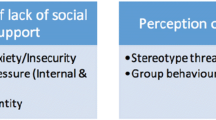Abstract
This paper describes an experimental method for determining the value of different types of information to military decision makers. The experimental method used a simple scenario and a set of serials constructed from cards, each presenting a single piece of information and presented sequentially. Each of a number of pairs of players were taken through the scenario and asked to judge how they would respond to the situation. This paper extends on the method presented in previous papers to consider the case of a decision in which the response can both increase and decrease as more information is presented. This allows a more general military problem to be considered, that of risk-taking behaviour in response to the possibility of chemical, biological, radiological or nuclear events.











Similar content being viewed by others
References
Daniel D, Holt J and Mathieson GL (2002). What influences a decision, 19 ISMOR.
Dodd L, Moffat J and Smith J (2006). Discontinuity in decision making when objectives conflict: A military command decision case study . J Opl Res Soc 57: 643–654.
Forder RA (2004). Operational research in the UK ministry of defence: An overview . J Opl Res Soc 55: 319–332.
Kahneman D, Slovic P and Tversky A (1982). Judgement Under Uncertainty: Heuristics and Biases . Cambridge University Press: Cambridge.
Kahneman D and Tversky A (eds) (2000). Choices, Values and Frames. Cambridge University Press: Cambridge.
Klein G (2001). Sources of Power. How People Make Decisions . MIT Press: Cambridge, MS.
Mathieson GL (2001). The impact of information on decision making, 18 ISMOR.
Medhurst J, Stanton I, Bird H and Berry A (2008). The value of information to decision makers—An experimental approach using card based decision gaming. J Opl Res Soc 60: 747–757.
Moffat J (2000). Representing the command and control process in simulation models of conflict . J Opl Res Soc 51: 431–439.
Moffat J (2002). Command and Control in the Information Age, Representing its Impact. TSO: London.
Moffat J and Medhurst J (2009). Modelling of human decision-making in simulation models of conflict using experimental gaming. Eur J Opl Res 196: 1147–1157.
Moffat J and Witty S (2002). Bayesian decision making and military command and control . J Opl Res Soc 53: 709–718.
Moffat J, Campbell I and Glover P (2004). Validation of the mission-based approach to representing command and control in simulation models of conflict . J Opl Res Soc 55: 340–349.
Perry W and Moffat J (2004). Information Sharing Among Military Headquarters, The Effects on Decisionmaking . RAND Corporation: Santa Monica, CA.
Zsambok C, Klein G (ed) (1997). Naturalistic Decision Making. LEA: Mahwah NJ.
Author information
Authors and Affiliations
Corresponding author
Additional information
Crown copyright 2008. Published with the permission of the Defence Science and Technology Laboratory on behalf of the Controller of HMSO.
Rights and permissions
About this article
Cite this article
Medhurst, J., Stanton, I. & Berry, A. Risk taking by decision makers—using card-based decision gaming to develop models of behaviour. J Oper Res Soc 61, 1561–1571 (2010). https://doi.org/10.1057/jors.2009.130
Received:
Accepted:
Published:
Issue Date:
DOI: https://doi.org/10.1057/jors.2009.130




